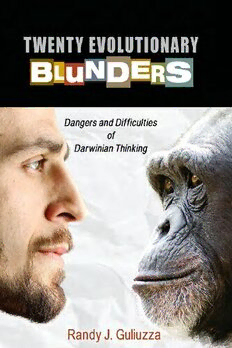Table Of ContentTWENTY
EVOLUTIONARY
BLUNDERS
Dangers and Difficulties of Darwinian Thinking
Randy J. Guliuzza
Dallas, Texas
ICR.org
TWENTY EVOLUTIONARY BLUNDERS
Dangers and Difficulties of Darwinian Thinking
BY RANDY J. GULIUZZA, P.E., M.D.
First printing: November 2017
Copyright © 2017 by the Institute for Creation Research. All rights reserved.
No portion of this book may be used in any form without written permis-
sion of the publisher, with the exception of brief excerpts in articles and
reviews. For more information, write to Institute for Creation Research,
P. O. Box 59029, Dallas, TX 75229.
All Scripture quotations are from the New King James Version.
ISBN: 978-1-946246-01-1
Library of Congress Catalog Number: 2017957395
Please visit our website for other books and resources: ICR.org
Printed in the United States of America.
Table of Contents
Introduction ...............................................................................................5
1 Evolutionary Predictions Fail the Reality Test ...............................9
2 The Eugenics Disaster ..................................................................19
3 The Imaginary Piltdown Man ........................................................29
4 Survival of the Fittest, Eugenics, and Abortion ...........................41
5 Our Useful Appendix—Evidence of Design, Not Evolution .........51
6 Are Whales and Evolution Joined at the Hip? .............................61
7 The “Poor Design” of Our Recurrent Laryngeal Nerve ................71
8 Berra’s Blunder ..............................................................................81
9 The Fatal Flaws of Living Fossils ..................................................91
10 Breaking Dollo’s Law ...................................................................101
11 The “Degenerate” Genetic Code? ...............................................111
12 The Imaginary Archaeoraptor ......................................................121
13 Evolutionists Can’t See Eye Design............................................129
14 Haeckel’s Embryos Born of Evolutionary Imagination ..............141
15 Imagining That Life Is Only Chemistry .......................................153
16 Neanderthals Were Subhuman in Imagination Only .................163
17 Evolutionary Psychology for Serious Tabloid Readers ............173
18 Convergent Evolution Is a Seductive Intellectual Swindle .......185
19 Evolutionists Falsely Predict “Junk DNA” ...................................197
20 Evolutionists Dismiss Evidence, Preferring Theory ..................207
Image Credits .........................................................................................218
About the Author ...................................................................................219
3
Introduction
T
his book takes a historical trip through the scientific
literature of evolutionists. It reveals how many of their
sensationalized theories have been exposed as chiefly
imaginary stories. Each chapter will show how the
power of imagination enables scientists to visualize what they
are looking for…even when it was never there. The content will
highlight key mystical premises of evolutionary theory—spe-
cifically, how nature is assumed to have creative intelligence.
Evolutionists envision nature as mysteriously exercising creative
agency, and they project volitional abilities onto the environ-
ment. In addition, each chapter usually teaches something new
about the important roles of worldviews, research programs, and
so on in the operation of science.
Knowing why these evolutionary blunders are the prod-
uct of extremely fertile imaginations also explains why they are
likely to happen again. A fundamental pillar of evolutionary
theory is extrapolation wherein evolutionists observe present-
day organisms and must imaginatively visualize backward
through vast periods of time to infer what their ancestors were
like. The amount of imagination conjured up is proportional
to the enormity of time. Darwin himself introduced this inap-
5
propriate methodology into scientific research which I have
called look-imagine-see. Evolutionists look at a feature of nature,
imagine an evolutionary origin, and then see what they expect.
This book documents that these blunders did not grow out
of the tentative, cloudy speculations of hypotheses, but from
imaginary stories with vivid details. Another reason to expect
a recurrence of more blunders is that Darwin’s death-driven
evolutionary mechanism is itself not a fully observable process,
but includes mystical events which, again, are envisioned only in
someone’s mind.
A theory is judged by its predictions. So accounting for
decades of failed predictions is another good reason to com-
pile the dismal evolutionary track record into a single reference.
Before any of the accounts in these chapters were blunders, they
were once believed to be a confirmation of an evolutionary pre-
diction. In their heyday, they were unabashedly taught as fact
and widely touted as evidence for the strength of evolution.
With much fanfare, they did their job of swaying public opin-
ion for evolution—even as scientific research was being mis-
led. But when they were eventually exposed as scientific flops,
evolutionists quietly swept them under the rug. They retained
discredited materials in textbooks and museum exhibits, and
deflected attention toward the self-correcting nature of the sci-
entific method. While exposing them as spectacular blunders
may seem to be bashing evolution, it is primarily targeted to
demonstrate the weakness of evolutionary theory. If nothing
more than for truth’s sake, there is a need to bring them to light.
Each topic carefully references the historical background
material and the latest literature which should assist as a starting
point if further research is desired.
6
Credit for the idea behind Twenty Evolutionary Blunders
goes to ICR’s CEO Dr. Henry M. Morris III. I am grateful for the
editorial expertise of Beth Mull, Truett Billups, Michael Stamp,
Christy Hardy, and the Director of Communications Jayme
Durant. Dr. Jeffery Tomkins, ICR’s geneticist, reviewed my
manuscripts, often with the help of ICR’s Science Writer Brian
Thomas. I’m particularly thankful for my wife June, who also
proofread each article and patiently acted as a sounding board
for long, and sometimes initially disorganized, monologues
which were useful to me for amplifying content on these topics.
7
1
Evolutionary Predictions
Fail the Reality Test
Summary
Both creationists and evolutionists make predictions based
upon their worldview. When it comes to genetics, creationists
predicted similarity. However, evolutionists predicted the oppo-
site. They predicted that similar features would have different
underlying genetics because there’s no way millions of years of
random mutations, in different ancestral lines, would happen to
be the same. Late in the 1970s, Hox genes were discovered, and
the evolutionists were proven spectacularly wrong. Hox genes
are similar genetic sequences that program similar features, and
they appear in such vastly different creatures such as flies, mice,
humans, elephants, and just about every animal in the kingdom.
Evolutionist Sean Carroll says, “Disparate animals were built
using not just the same kinds of tools, but indeed, the very same
genes!” As an amazing confirmation of creation predictions,
Hox genes show that creatures are the result of common design,
not random mutations.
9

